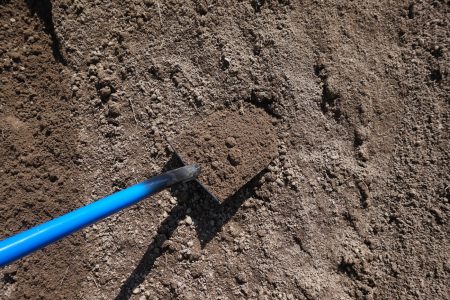When farming or agriculture comes to mind it directly means soil. As we all know that soil is a base element of agriculture without which farmers would not be able to grow plants. Soil is used to grow food for both humans and animals.

Farmers can't imagine it's life without soil except in advance technologies where soilless farming such as hydroponics is being practiced, but eventually soil sets the base to agriculture industry.
Besides serving for agriculture ,forestry and biodiversity , soil also act as a filtering, buffering and transformation layer for the activities between atmosphere and groundwater. It also protects the food chain cycle and prevents water against pollution.
History :
The term soil was basically derived from the word "SOLUM" , which means FLOOR. Generally soil reffers to the loose surface of earth as identified from tha original rock and minerals from which it is derived through weathering process.
As soil provides nutrients, water, air and anchorage and support life on earth it can be called as Soul Of Infinite Life ( SOIL).
Soil profile:
The vertical section of the soil showing the various layers from the surface to the unaffected parent material is known as soil profile.
A study of soil profile is important as it is historic record of all the soil forming process and it forms the basis for the study in pedagogical investigations. Soil profile is the key for soil classification and forms the basis for practical utility of soils.
The various layers in soil profile are known as horizons. A soil profile contain three main horizons as horizon A, horizon B and horizon C. A hypothetical mineral soil profile will include O, A, B, C and R master horizons and possible sub- horizons.
 |
| Soilpofile |
The horizons are:
O – (humus or organic) Mostly organic matter such as decomposing leaves. The O horizon is thin in some soils, thick in others, and not present at all in others.
A - (topsoil) Mostly minerals from parent material with organic matter incorporated. A good material for plants and other organisms to live.
B – (subsoil) Rich in minerals that leached (moved down) from the A or E horizons and accumulated here.
C – (parent material) The deposit at Earth’s surface from which the soil developed.
R – (bedrock) A mass of rock such as granite, basalt, quartzite, limestone or sandstone that forms the parent material for some soils – if the bedrock is close enough to the surface to weather. This is not soil and is located under the C horizon.
Soil texture:
Every soil has a mixture of three main components i.e sand, silt and clay. Below is a soil triangle to verify the soil texture of the given soil. |
| Soil triangle |
The soil triangle shows you what kind of soil you are working on by taking into consideration the soil’s components. Loam is the most fertile type of soil and has a equal proportions of these components.
SAND-
Sand most extensively used in construction material. It consists of particles of rock and hard minerals, such as silicon dioxide.Sand particles are visible with naked eyes as they are the largest type of soil particles. This property of sand makes them relatively stable, large size particle increases and improves drainage in tight soil. This creates plant-growth supports qualities or tilt.
Sand
SILT-
Silt soil is intermediate size between sand and clay. It is sediment material carried by water during flood. It forms a fertile deposit on valleys floor. The particle size of silt ranges from 0.002mm and 0.06 mm. When it is wet, it blends seamlessly with water to form fine, smooth and runny puddles of mud. It can be used to form balls and other shapes.
CLAY -
Clay soil particles are particles with finest size measuring fewer than 0.002 mm in size. It consists of microscopic and sub-microscopic particles derived from the chemical decomposition of rocks. Clay is a fine grained cohesive soil. The particles are so fine that they stick together readily and form gluey texture whether wet or dry.
Clay when mixed with water
LOAM -
Loam is soil type which is a mixture of clay, sand and silt. This is a combo pack soil with the benefits of the three different soil textures, thus favors water retention, air circulation, provides good drainage and increases fertility. Loam can be either sandy or clay. This depends upon the predominant composition. This property of loam makes it easy to work with.
Loam
Conclusion:
The soil is the base of farming as it serves for both human and animals. Every living being is directly or indirectly depended on soil for their livelihood. The soil consists of various layers depending upon its structure, age, organic matter, etc classified as soil profile . The soil is formed by three major components i.e sand, silt and clay in which loam has the equal proportions of these three components and is most fertile.
These were some basic information about soil and now I think you all are bit knowledgeable about soil . It has many more hidden facts inside it which will be continued in the next blog till then be curious and keep learning.
-------------------------------------------------------------------------------------
To read the other blog posts click on the links given below:-







Nicely written and understandable
ReplyDeletevery helpful 👌
ReplyDeleteThank u
DeleteHope it will be fruitfull for you.
DeleteWell described!
ReplyDeleteGreat work... Thanks for the post ☺️
ReplyDeletePerfectly presented👍
ReplyDeleteThank u
DeleteThank you
ReplyDeleteSoil information is good
ReplyDeleteAgriculture Guide